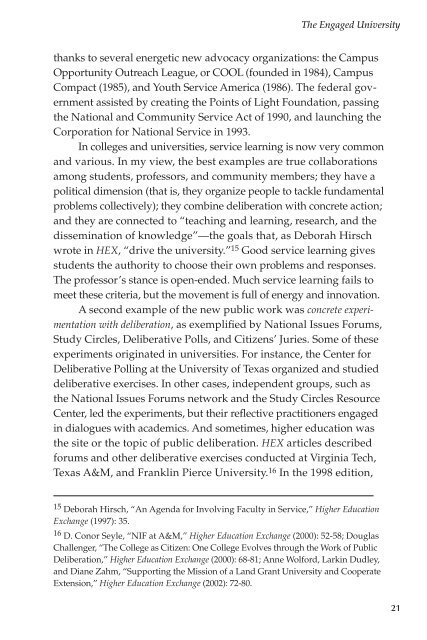Agent of Democracy - Society for College and University Planning
Agent of Democracy - Society for College and University Planning
Agent of Democracy - Society for College and University Planning
You also want an ePaper? Increase the reach of your titles
YUMPU automatically turns print PDFs into web optimized ePapers that Google loves.
The Engaged <strong>University</strong><br />
thanks to several energetic new advocacy organizations: the Campus<br />
Opportunity Outreach League, or COOL (founded in 1984), Campus<br />
Compact (1985), <strong>and</strong> Youth Service America (1986). The federal government<br />
assisted by creating the Points <strong>of</strong> Light Foundation, passing<br />
the National <strong>and</strong> Community Service Act <strong>of</strong> 1990, <strong>and</strong> launching the<br />
Corporation <strong>for</strong> National Service in 1993.<br />
In colleges <strong>and</strong> universities, service learning is now very common<br />
<strong>and</strong> various. In my view, the best examples are true collaborations<br />
among students, pr<strong>of</strong>essors, <strong>and</strong> community members; they have a<br />
political dimension (that is, they organize people to tackle fundamental<br />
problems collectively); they combine deliberation with concrete action;<br />
<strong>and</strong> they are connected to “teaching <strong>and</strong> learning, research, <strong>and</strong> the<br />
dissemination <strong>of</strong> knowledge”—the goals that, as Deborah Hirsch<br />
wrote in HEX, “drive the university.” 15 Good service learning gives<br />
students the authority to choose their own problems <strong>and</strong> responses.<br />
The pr<strong>of</strong>essor’s stance is open-ended. Much service learning fails to<br />
meet these criteria, but the movement is full <strong>of</strong> energy <strong>and</strong> innovation.<br />
A second example <strong>of</strong> the new public work was concrete experimentation<br />
with deliberation, as exemplified by National Issues Forums,<br />
Study Circles, Deliberative Polls, <strong>and</strong> Citizens’ Juries. Some <strong>of</strong> these<br />
experiments originated in universities. For instance, the Center <strong>for</strong><br />
Deliberative Polling at the <strong>University</strong> <strong>of</strong> Texas organized <strong>and</strong> studied<br />
deliberative exercises. In other cases, independent groups, such as<br />
the National Issues Forums network <strong>and</strong> the Study Circles Resource<br />
Center, led the experiments, but their reflective practitioners engaged<br />
in dialogues with academics. And sometimes, higher education was<br />
the site or the topic <strong>of</strong> public deliberation. HEX articles described<br />
<strong>for</strong>ums <strong>and</strong> other deliberative exercises conducted at Virginia Tech,<br />
Texas A&M, <strong>and</strong> Franklin Pierce <strong>University</strong>. 16 In the 1998 edition,<br />
15 Deborah Hirsch, “An Agenda <strong>for</strong> Involving Faculty in Service,” Higher Education<br />
Exchange (1997): 35.<br />
16 D. Conor Seyle, “NIF at A&M,” Higher Education Exchange (2000): 52-58; Douglas<br />
Challenger, “The <strong>College</strong> as Citizen: One <strong>College</strong> Evolves through the Work <strong>of</strong> Public<br />
Deliberation,” Higher Education Exchange (2000): 68-81; Anne Wol<strong>for</strong>d, Larkin Dudley,<br />
<strong>and</strong> Diane Zahm, “Supporting the Mission <strong>of</strong> a L<strong>and</strong> Grant <strong>University</strong> <strong>and</strong> Cooperate<br />
Extension,” Higher Education Exchange (2002): 72-80.<br />
21

















